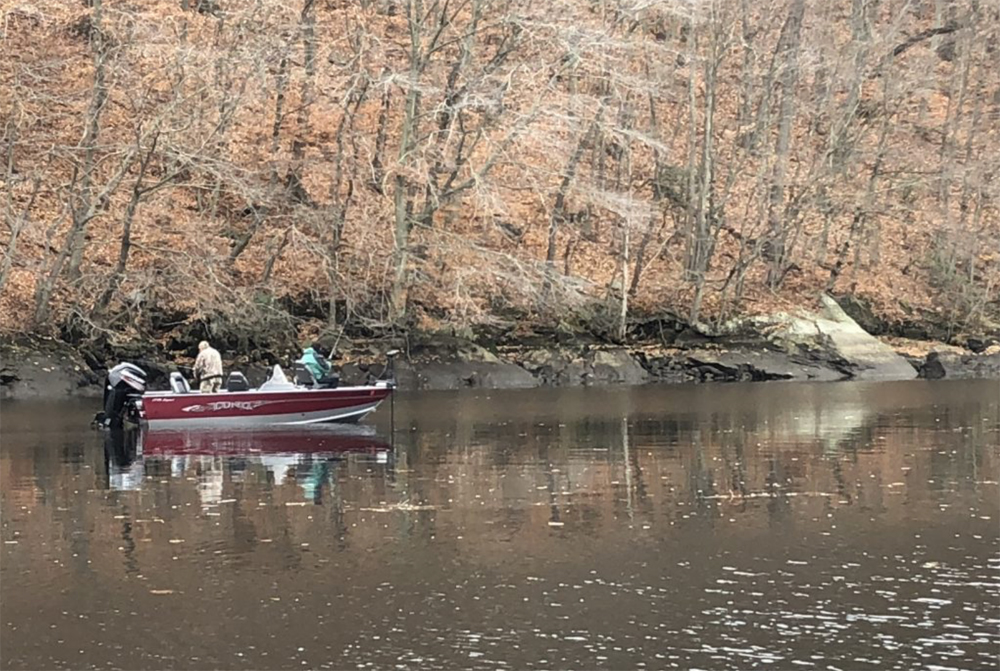

If you’re a New England saltwater fisherman who can’t bring yourself to call it quits, the coastal rivers of Connecticut offer consistent action with striped bass through the winter.
I got my first taste of this fishery a few years back, on the Housatonic River in western Connecticut. The river is one a handful of estuaries in the state that host a population of striped bass that stick around through the winter. For whatever reason, these “holdover” bass choose not to migrate south with their brethren come late fall, and remain available to anglers willing to brave the elements.

My guide was Capt. Ian Devlin, a longtime fly- and light-tackle guide in the Norwalk area. Devlin has fished the waters of western Connecticut since he was a boy, and still brings a youthful enthusiasm, as well as a naturalist’s sensibility, to his pursuit of New England’s inshore species. In his 20’s, he spent time guiding in Florida, and still uses his trusty 17-foot Lake & Bay flats skiff to fish his home waters.
I met Devlin at the public launch in Stratford, on a late November morning that saw temperatures in the mid-20’s. The ramp docks were icy, reminding me that safety is paramount when fishing at this time of year.
As we idled north, occasionally poking into sheltered coves, Devlin watched his depthsounder intently. When he marks fish, he makes a note of the spot so he can return to it later if he fails to find a concentration of bass farther upriver. He says that the fish can be virtually anywhere inside the lower river when they first arrive in early winter, before settling into their more predictable haunts through March.
Oddly enough, the Housatonic stripers, as well as those that winter-over in the Thames and Norwalk River systems, seem to prefer the cooler river water as opposed to the relatively warmer Long Island Sound. What they feed on during the long, cold winter—or whether they feed at all—is another mystery surrounding the holdover bass.
As we neared the head of tide in Derby, where the Housatonic and Naugatuck Rivers merge, Devlin’s sounder lit up with the marks of fish hugging the bottom. Further evidence of their presence was provided by several shore fishermen, who were busily landing fish from a sandy bank. A few casts later and I hooked my first Housy holdover on a four-inch, soft-plastic Al Gag Whip-It Fish rigged on a half-ounce jighead.
This rig is ideal for fishing in a light current in 15 to 30 feet of water. The important thing is to get the jig down to the bottom, as the fish normally won’t move very far to chase a lure. A slow retrieve is also required. Cast the jig out, let it settle to the bottom then reel it in using a steady retrieve interspersed with gentle lifts of the rod to hop it over the bottom.
As the tide began to ebb, Devlin moved us steadily downriver. We hooked fish on virtually every cast as peregrine falcons and blue herons regarded us from shore. Eventually more fishermen arrived, some in kayaks, but there was plenty of room—and fish—for all. Indeed, there must have been well over ten thousand stripers in the river. Most weighed a few pounds, with a few pushing keeper size, but Devlin has taken much bigger fish in the river—up to 25 pounds. In past years, bass up to 40 pounds have been pulled from the Housy, mostly at night on large soft-plastic lures. Occasionally, abeit rarely, Atlantic salmon are also taken in the lower river.
Since the majority of holdover fish are schoolies, Devlin typically fishes a light spinning reel filled with 15-pound-test braided line and a seven-foot, medium-action graphite rod. The leader is three feet of 12- to 15-pound fluorocarbon, connected via a double uni knot, Alberto knot, Slim Beauty knot, or Bristol knot.
Devlin and I fished through the end of the dropping tide, eventually switching over to nine-weight fly gear. A deep-sink line or shooting head is mandatory for reaching the bottom-hugging fish, and a large, four-inch Clouser Minnow provided the right kind of profile and action the fish liked. Large Deceivers also work and are easier to cast, but take longer to reach the right level.
Add me to the list of fishermen that Ian Devlin has introduced to a new and different world of striper fishing. My day on the Housatonic was an eye-opening—if bone-chilling—experience, for sure, and a good example of how you can always learn something new when it comes to fishing—and stripers.
